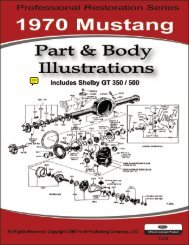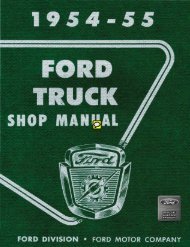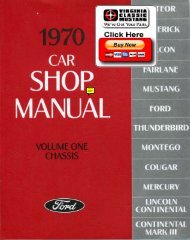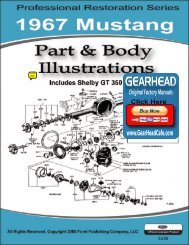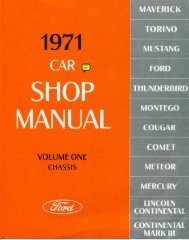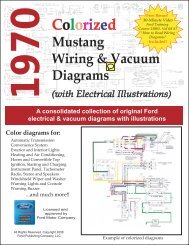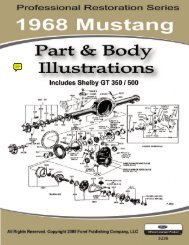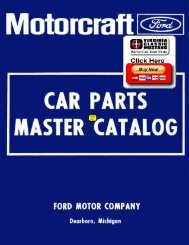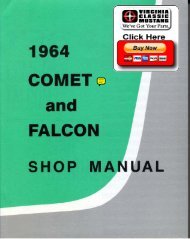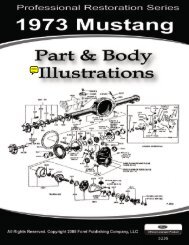DEMO - 1965 Ford Truck Shop Manual - ForelPublishing.com
DEMO - 1965 Ford Truck Shop Manual - ForelPublishing.com
DEMO - 1965 Ford Truck Shop Manual - ForelPublishing.com
Create successful ePaper yourself
Turn your PDF publications into a flip-book with our unique Google optimized e-Paper software.
212 GROUP 2-BRAKES<br />
tern on some trucks is assisted by a<br />
vacuum booster which may be installed<br />
as either standard or optional<br />
equipment. Other trucks use an optional<br />
<strong>com</strong>pressed air booster (airhydraulic<br />
unit) to provide a power<br />
assist to the hydraulic brakes.<br />
The master cylinder converts physical<br />
force from the brake pedal and<br />
booster into hydraulic pressure<br />
against the pistons in the wheel cylinders.<br />
The wheel cylinder pistons in<br />
turn convert hydraulic pressure back<br />
into physical force at the brake shoes.<br />
Ail <strong>Ford</strong> truck brakes have internal<br />
expanding shoes. The different<br />
types of brake assembly vary in the<br />
way that the shoes are anchored, in<br />
the number of wheel cylinders used<br />
at each wheel, and in the number of<br />
pistons in the wheel cylinder.<br />
In the single anchor type, both<br />
brake shoes are mounted to the same<br />
anchor and are actuated by one wheel<br />
cylinder. In the uni-servo, single<br />
anchor brake, the wheel cylinder has<br />
only one piston which exerts force<br />
against the upper end of the primary<br />
shoe (Fig. 12). In the duo-servo,<br />
single anchor brake, the wheel cylinder<br />
has two pistons. One piston<br />
exerts force against the upper end<br />
of the primary shoe; the other piston<br />
exerts force against the upper end of<br />
the secondary shoe (Fig. 2).<br />
In the double anchor type, each<br />
shoe is mounted to a separate<br />
anchor. The shoes are actuated by<br />
one duo-servo (two piston) cylinder<br />
at the upper end (Fig. 5).<br />
The front wheels of some trucks<br />
are equipped with two cylinders,<br />
each having one piston (Fig. 13). The<br />
piston in one cylinder exerts force<br />
against one end of one shoe; the<br />
piston in the other cylinder exerts<br />
force against the opposite end of the<br />
other shoe.<br />
The rear wheels of some trucks<br />
are equipped with two cylinders, each<br />
having two pistons (four pistons<br />
total). Each of the four pistons exerts<br />
force against one end of one shoe<br />
(Figs. 14 and 15).<br />
SELF ADJUSTING BRAKES<br />
Single anchor duo servo type brake<br />
assemblies equipped with a self adjusting<br />
mechanism are used front and<br />
rear on F- and P-100 trucks.<br />
The self-adjusting brake mechanism<br />
consists of a cable, cable guide,<br />
adjusting lever, and adjuster spring<br />
(Fig. 2). The cable is hooked over<br />
the anchor pin at the top and is connected<br />
to the lever at the bottom.<br />
The cable is connected to the secondary<br />
brake shoe by means of the<br />
cable guide. The adjuster spring is<br />
hooked to the primary brake shoe<br />
and to the lever.<br />
The automatic adjuster operates<br />
only while the truck is moving rearward<br />
and the brake pedal pressure is<br />
firmly applied.<br />
With the truck moving rearward<br />
and the brakes applied, the "wraparound"<br />
action of the shoes following<br />
the drum forces the upper end<br />
of the primary shoe against the anchor<br />
pin. The action of the wheel<br />
cylinder moves the upper end of the<br />
secondary shoe away from the anchor<br />
pin. The movement of the secondary<br />
shoe causes the cable to<br />
pull the adjusting lever upward and<br />
against the end of a tooth on the<br />
adjusting screw star-wheel. The upward<br />
travel of the lever increases as<br />
lining wear increases. When the lever<br />
can move upward far enough it<br />
passes over the end of the tooth and<br />
engages the tooth. When the brakes<br />
are released, the adjuster spring pulls<br />
the lever downward causing the starwheel<br />
to turn and expand the shoes.<br />
The star-wheel is turned 1 tooth at<br />
a time as the linings progressively<br />
wear.<br />
With the truck moving forward<br />
and the brakes applied, the secondary<br />
shoe is against the anchor pin<br />
and the primary shoe is moved<br />
toward the drum. Therefore, the adjuster<br />
does not operate.<br />
The rear brake assembly is basically<br />
the same as the front brake.<br />
The conventional parking brake lever,<br />
link, and spring are used in the<br />
rear brake.<br />
The anchor pins on F- and P-100<br />
brakes are fixed and non-adjustable.<br />
ANCHOR PIN PLATE<br />
ANCHOR PIN.<br />
PARKING BRAKE LINK<br />
FORWARD<br />
ANCHOR PIN PLATE<br />
CAB|_E<br />
ANCHOR PIN<br />
SECONDARY<br />
ANCHOR FITTING<br />
PRIMARY SHOE -TO-<br />
ANCHOR SPRING<br />
FORWARD<br />
LINK SPRING<br />
SHOE-TO-ANCHOR SPRING<br />
PARKING BRAKE LEVER<br />
RETAINING CLIP<br />
PRIMARY<br />
SHOE<br />
CABLE<br />
GUIDE<br />
SECONDARY<br />
SHOE<br />
CABLE<br />
AUTOMATIC<br />
ADJUSTER SPRING<br />
PARKING BRAKE CABLE<br />
HOUSING RETAINER<br />
REAR BRAKE<br />
FEG. 2-Self Adjusting Brake Assemblies<br />
PIVOT HOOK<br />
PARKING BRAKE<br />
CABLE AND<br />
HOUSING<br />
SHOE<br />
HOLD-DOWN<br />
SPRINGS<br />
PARKING BRAKE LEVER<br />
AUTOMATIC<br />
ADJUSTER SPRING<br />
PIVOT NUT<br />
CABLE<br />
HOOK<br />
SECONDARY<br />
SHOE<br />
ADJUSTING LEVER<br />
SOCKET<br />
ADJUSTING SCREW<br />
H1339-A




